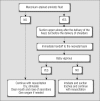Prevention of meconium aspiration syndrome: an update and the Baylor experience
- PMID: 19381312
- PMCID: PMC2666857
- DOI: 10.1080/08998280.2009.11928491
Prevention of meconium aspiration syndrome: an update and the Baylor experience
Abstract
The approach to preventing meconium aspiration syndrome (MAS) in the newborn has changed markedly over the last 30 years. In the late 1970s, all infants born through meconium-stained amniotic fluid (MSAf) had upper-airway suctioning before delivery of the shoulders and then had tracheal intubation and suctioning in the delivery room. Now suctioning of the upper airway is no longer recommended, and only "depressed" infants are intubated for tracheal suctioning. The incidence of MAS and the associated high mortality rate have both declined significantly over time. This is due to improved antepartum and intrapartum obstetrical management as well as the postdelivery resuscitation of the neonate born through MSAf. MAS is no longer considered to be solely a postnatal disorder that is preventable with routine delivery room suctioning of the trachea; rather, it is considered a complex and multifactorial disorder with antenatal as well as intrapartum factors. The incidence and severity of MAS have been positively affected by a combined obstetrical and neonatal approach to the infant born through MSAf. In this article, we detail our experience at Baylor University Medical Center with MAS and its prevention and review the current literature.
Figures


Similar articles
-
Yield of meconium in non-vigorous neonates undergoing endotracheal suctioning and profile of all neonates born through meconium-stained amniotic fluid: a prospective observational study.Paediatr Int Child Health. 2018 Nov;38(4):266-270. doi: 10.1080/20469047.2018.1508809. Epub 2018 Aug 30. Paediatr Int Child Health. 2018. PMID: 30160618
-
Evolution of Delivery Room Management for Meconium-Stained Infants: Recent Updates.Adv Neonatal Care. 2018 Aug;18(4):267-275. doi: 10.1097/ANC.0000000000000522. Adv Neonatal Care. 2018. PMID: 29889726
-
Meconium aspiration syndrome: do we know?Turk J Pediatr. 2011 Mar-Apr;53(2):121-9. Turk J Pediatr. 2011. PMID: 21853647 Review.
-
Endotracheal suctioning for prevention of meconium aspiration syndrome: a randomized controlled trial.Eur J Pediatr. 2019 Dec;178(12):1825-1832. doi: 10.1007/s00431-019-03463-z. Epub 2019 Oct 7. Eur J Pediatr. 2019. PMID: 31588974 Clinical Trial.
-
The pros and cons of suctioning at the perineum (intrapartum) and post-delivery with and without meconium.Semin Fetal Neonatal Med. 2008 Dec;13(6):375-82. doi: 10.1016/j.siny.2008.04.001. Epub 2008 May 13. Semin Fetal Neonatal Med. 2008. PMID: 18474453 Review.
Cited by
-
Association of Meconium-Stained Amniotic Fluid and Histological Chorioamnionitis with Fetal Inflammatory Response in Preterm Deliveries.Children (Basel). 2025 Apr 7;12(4):477. doi: 10.3390/children12040477. Children (Basel). 2025. PMID: 40310124 Free PMC article.
-
Risk factors differentiating mild/moderate from severe meconium aspiration syndrome in meconium-stained neonates.Obstet Gynecol Sci. 2015 Jan;58(1):24-31. doi: 10.5468/ogs.2015.58.1.24. Epub 2015 Jan 16. Obstet Gynecol Sci. 2015. PMID: 25629015 Free PMC article.
-
Approach to the Connection between Meconium Consistency and Adverse Neonatal Outcomes: A Retrospective Clinical Review and Prospective In Vitro Study.Children (Basel). 2021 Nov 24;8(12):1082. doi: 10.3390/children8121082. Children (Basel). 2021. PMID: 34943278 Free PMC article.
-
Impact of Physician Training Level on Neonatal Tracheal Intubation Success Rates and Adverse Events: A Report from National Emergency Airway Registry for Neonates (NEAR4NEOS).Neonatology. 2021;118(4):434-442. doi: 10.1159/000516372. Epub 2021 Jun 10. Neonatology. 2021. PMID: 34111869 Free PMC article.
-
Prevalence and Associated Factors of Perinatal Asphyxia in Neonates Admitted to Ayder Comprehensive Specialized Hospital, Northern Ethiopia: A Cross-Sectional Study.Int J Pediatr. 2020 Feb 14;2020:4367248. doi: 10.1155/2020/4367248. eCollection 2020. Int J Pediatr. 2020. PMID: 32110243 Free PMC article.
References
-
- Wiswell TE, Tuggle JM, Turner BS. Meconium aspiration syndrome: have we made a difference? Pediatrics. 1990;85(5):715–721. - PubMed
-
- Davis RO, Phillips JB, 3rd, Harris BA, Jr, Wilson ER, Huddleston JF. Fatal meconium aspiration syndrome occurring despite airway management considered appropriate. Am J Obstet Gynecol. 1985;151(6):731–736. - PubMed
-
- James LS. Resuscitation procedures in the delivery room. In: Abramson H, editor. Resuscitation of the Newborn Infant. St. Louis, MO: CV Mosby Co; 1960. pp. 141–161.
-
- Gregory GA, Gooding CA, Phibbs RH, Tooley WH. Meconium aspiration in infants—a prospective study. J Pediatr. 1974;85(6):848–852. - PubMed
-
- Ting P, Brady JP. Tracheal suction in meconium aspiration. Am J Obstet Gynecol. 1975;122(6):767–771. - PubMed
LinkOut - more resources
Full Text Sources
